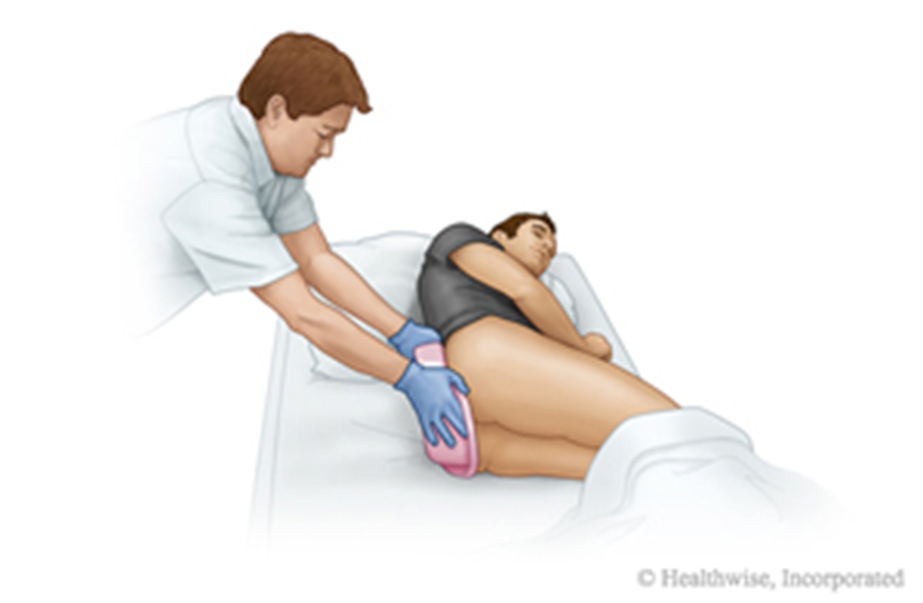A nurse observes a practical nurse (PN) pouring warm water over the perineal area of a female client who has frequent urinary incontinence while the client is positioned on a bedpan. Which action should the nurse take?
Evaluate the effectiveness of this measure to stimulate client voiding.
Recommend a complete bath to cleanse the perineal area more fully.
Suggest contacting the healthcare provider for a prescription for catheter insertion.
Instruct the PN that this technique promotes infection in elderly females.
The Correct Answer is A
Choice A reason: Pouring warm water over the perineal area can stimulate the micturition reflex, which may help the client void. It is a non-invasive, first-line intervention to promote natural voiding in clients with urinary incontinence. The nurse should evaluate its effectiveness as it can be a simple yet effective method to assist the client.
Choice B reason: While recommending a complete bath may help maintain hygiene, it does not directly address the immediate need to stimulate voiding. The nurse's priority is to manage the incontinence issue effectively and a bath can be considered after addressing the client's immediate needs.
Choice C reason: Suggesting catheter insertion may be premature without first attempting less invasive measures. Catheterization carries risks such as infection and should be considered only when other interventions are ineffective or not feasible.
Choice D reason: There is no evidence to suggest that pouring warm water over the perineal area promotes infection in elderly females. In fact, proper perineal care is essential in preventing infections, especially in clients with incontinence.

Nursing Test Bank
Naxlex Comprehensive Predictor Exams
Related Questions
Correct Answer is ["A","B","C","D"]
Explanation
The client has rested well throughout the night with a continuous positive airway pressure (CPAP) device in place. Sequential devices are in place for venous thromboembolism prevention. The client ambulated 100 yards (91 meters) last night and 200 yards (183 meters) this morning. She reports pain rating of 2 on 0 to 10 scale, located in the abdomen, described as aching. She has tolerated fluids throughout the night with no nausea or vomiting.
Assessment findings
- Neurological Alert and oriented times 4.
- Cardiovascular WNL.
- Respiratory WNL.
- Gastrointestinal/Genitourinary Voided twice throughout night, urine clear amber in appearance. Reports no dysuria. No bowel movement but the client is passing gas.
- Integumentary 4 abdominal incisions from laparoscopic procedure sealed with surgical glue. No drainage, redness, or edema present.
- Musculoskeletal Reported chronic knee pain. 5+ strength in bilateral upper extremities, 5+ strength in bilateral lower extremities.
Correct Answer is ["B","C","D","F"]
Explanation
Choice A Reason: Selecting only food items with no fat is not recommended because some fats, particularly unsaturated fats, are beneficial for health and should be included in a balanced diet.
Choice B Reason: Taking a cinnamon supplement may be beneficial as some studies suggest that cinnamon can help lower blood sugar levels and improve insulin sensitivity.
Choice C Reason: Minimizing the number of refined grains in the diet is advised because refined grains can have a negative impact on blood sugar control and may increase the risk of type 2 diabetes.
Choice D Reason: Eliminating sugary beverages and juices from the diet is beneficial as these can lead to spikes in blood sugar levels and contribute to weight gain, which is a risk factor for type 2 diabetes.
Choice E Reason: Doubling the usual amount of protein in the diet is not necessary and could lead to an excessive intake of calories. Protein should be consumed in moderation and as part of a balanced diet.
Choice F Reason: Increasing the amount of dietary fiber is recommended because fiber can help manage blood sugar levels and reduce the risk of developing type 2 diabetes.
Whether you are a student looking to ace your exams or a practicing nurse seeking to enhance your expertise , our nursing education contents will empower you with the confidence and competence to make a difference in the lives of patients and become a respected leader in the healthcare field.
Visit Naxlex, invest in your future and unlock endless possibilities with our unparalleled nursing education contents today
Report Wrong Answer on the Current Question
Do you disagree with the answer? If yes, what is your expected answer? Explain.
Kindly be descriptive with the issue you are facing.
